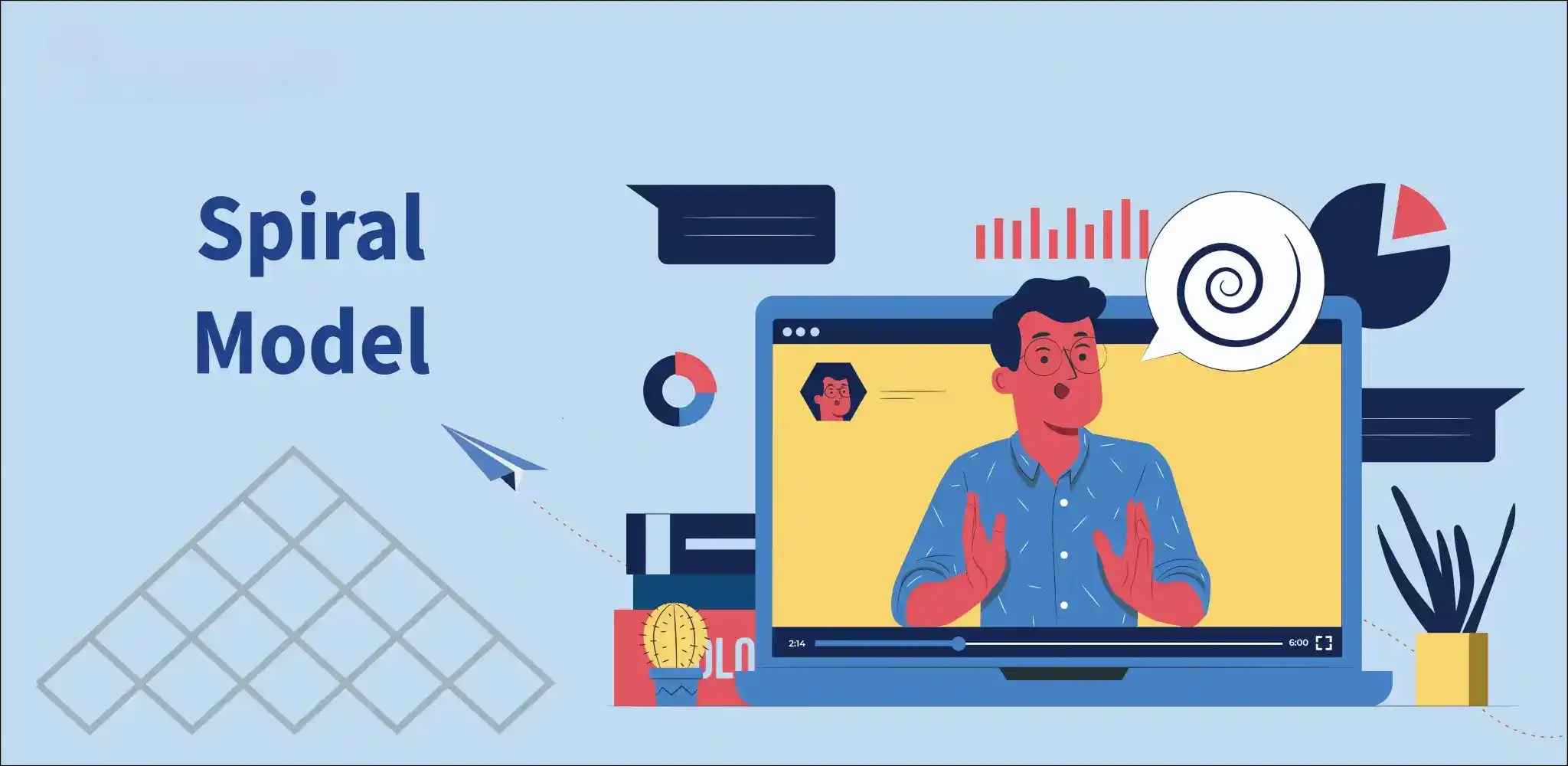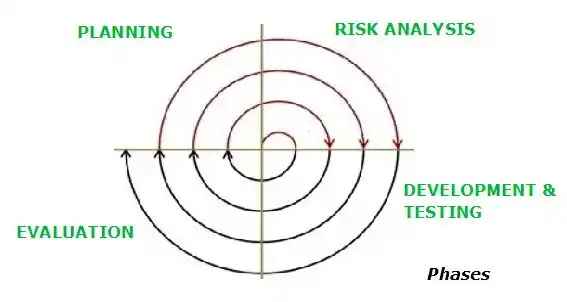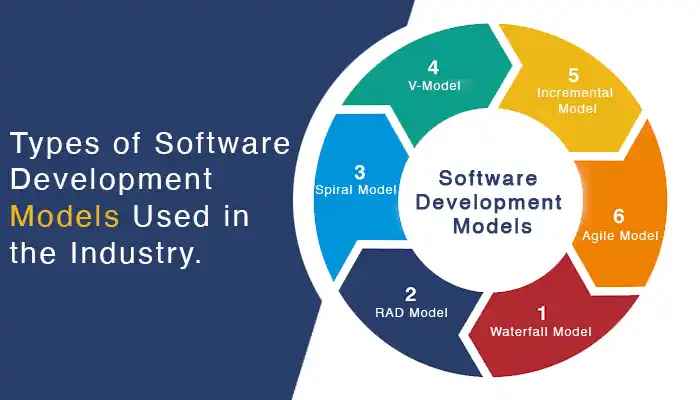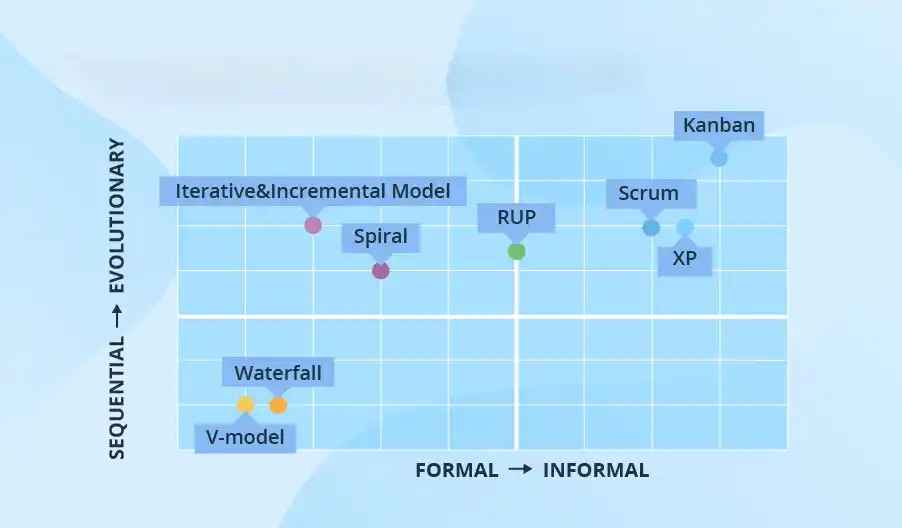Spiral Model in Software Engineering Lifecycle
Updated on : 14 May 2025

Image Source: google.com
Table Of Contents
- 1. Introduction
- 2. Primary Phases Involved in the Spiral Methodology
- 3. Focus on Risk Assessment in Spiral Development
- 4. Integration of Spiral Model with Other Development Techniques
- 5. Repetitive Nature of Spiral-Based Development
- 6. Ideal Scenarios for Applying the Spiral Model
- 7. Advantages of Using the Spiral Approach
- 8. Potential Drawbacks and Issues of the Spiral Model
- 9. Graphical Depiction of the Spiral Development Cycle
- 10. Comparison with Other Software Development Life Cycle (SDLC) Models
- 11. Essential Competencies for Spiral Model Execution
- 12. FAQs
Table Of Contents
Introduction
The Spiral Model in Software Engineering Lifecycle is like a journey through loops—each spiral adds improvements, tackles risks, and refines the software. Perfect for complex projects, this model blends planning and flexibility to deliver smarter, safer, and better solutions step by step.
Primary Phases Involved in the Spiral Methodology

Image Source: google
The Spiral Model in Software Engineering Lifecycle follows an iterative process with risk analysis and continuous refinement.
1️ Planning Phase 📝
- Identify objectives and constraints
- Estimate cost, schedule, and resources
- Define alternatives and strategies
2️ Risk Analysis Phase ⚠️
- Identify potential risks
- Analyze and resolve risks
- Develop risk mitigation strategies
3️ Engineering Phase 🛠️
- Develop prototypes or actual software modules
- Perform coding, testing, and implementation
- Integrate and verify components
4️ Evaluation Phase 🔍
- Customer evaluates the product
- Gather feedback and assess results
- Plan for the next iteration
🔄 This cycle repeats for each iteration, refining the product until it's complete.
💡 The Spiral Model in Software Engineering Lifecycle is ideal for large, complex, and high-risk projects.
Focus on Risk Assessment in Spiral Development
| 🔍 Risk Aspect | ✅ In Spiral Model | ⚠️ Without Risk Focus |
|---|---|---|
| Identification | Risks are identified in each phase. | Risks may be overlooked until later stages. |
| Analysis | Each risk is carefully analyzed for impact. | Little to no detailed risk analysis done. |
| Mitigation | Plans are made to reduce or eliminate risks. | Reactive approach after risks cause problems. |
| Cost Control | Helps avoid costly rework through early risk handling. | Higher cost due to unexpected failures. |
| Decision Making | Informed decisions based on known risks. | Decisions made with limited risk awareness. |
| Project Success | Increases chances of successful delivery. | Higher chance of project delays or failures. |
Integration of Spiral Model with Other Development Techniques

Image Source: google
| 🔧 Development Technique | 🌀 Integration with Spiral Model |
|---|---|
| Agile | Combines iterative cycles of Agile with risk analysis from the Spiral Model for continuous improvement and adaptation. |
| Waterfall | Can be used in early phases for detailed planning and documentation, then switch to Spiral for risk management and iterative development. |
| Prototyping | Spiral Model supports prototyping in each iteration, refining prototypes with user feedback at every loop. |
| DevOps | Risk management from the Spiral Model complements continuous integration and delivery practices of DevOps. |
| V-Model | Spiral Model can be integrated for risk analysis during each phase, while V-Model handles verification and validation. |
| Incremental Model | Spiral Model supports incremental development with risk management and refinement at each iteration. |
| Rapid Application Development (RAD) | Spiral Model helps in handling complex requirements and user feedback in each cycle of RAD's iterative process. |
Repetitive Nature of Spiral-Based Development
| 🔧 Aspect | 🔄 Spiral-Based Development | ⏳ Traditional Models |
|---|---|---|
| Iteration | Continuous cycles with refinements in each phase. | Usually follows one linear flow. |
| Feedback | Collected after every cycle to improve the next. | Limited or late feedback (often at the end). |
| Risk Management | Identifies and reduces risks in each loop. | Risks often found late in the process. |
| Flexibility | Adapts easily to changing requirements. | Rigid structure; difficult to change mid-process. |
| Development Focus | Emphasizes on prototypes and customer evaluation. | Full product built before customer sees it. |
| Progress Tracking | Clearly visible through each spiral loop. | Progress tracked only at key milestones. |
Ideal Scenarios for Applying the Spiral Model
The Spiral Model in Software Engineering Lifecycle is best suited for complex and high-risk projects that need flexibility and continuous improvement.
🔁 1. Large and Complex Projects
- Ideal when requirements are not fully understood at the beginning
- Helps manage size and complexity with iterative development
⚠️ 2. High-Risk Projects
- Useful when there's uncertainty in technology or requirements
- Risk analysis at every stage reduces potential failures
💬 3. Frequent Client Feedback Needed
- Perfect for projects where customer input is critical
- Allows changes based on client feedback after every cycle
🔧 4. Projects with Evolving Requirements
- Adapts to changes easily due to its iterative nature
- Suitable when requirements may change during development
🧪 5. Need for Prototyping
- Encourages creating working models early
- Useful when the final product needs to be visualized early
✅ Overall, the Spiral Model in Software Engineering Lifecycle is ideal for projects needing flexibility, risk control, and regular user involvement.

Need help navigating the SDLC for your project?
Advantages of Using the Spiral Approach

Image Source: google
| 🔧 Aspect | 🌀 Spiral Approach Advantage |
|---|---|
| Risk Management | Identifies and handles risks early in each cycle. |
| Flexibility | Easily adapts to changes in requirements. |
| Customer Feedback | Frequent feedback ensures alignment with expectations. |
| Prototyping | Supports early creation of working models. |
| Progress Tracking | Clear milestones in every spiral loop. |
| Requirement Refinement | Improves requirements through iteration. |
| Cost Control | Detects costly issues early to avoid rework. |
| Reuse | Encourages reuse of components in each phase. |
You Might Also Like
Potential Drawbacks and Issues of the Spiral Model
| ⚠️ Drawback | 📌 Description |
|---|---|
| Complexity | The model is complex and may be difficult to manage for small projects. |
| Costly | High cost due to continuous prototyping and reviews. |
| Time-Consuming | Longer development time because of multiple iterations. |
| Requires Expertise | Needs experienced project managers and developers to handle risks and planning. |
| Risk of Endless Loop | Without clear endpoints, the project may continue spiraling indefinitely. |
| Not Suitable for Small Projects | Overhead of spiral process is too much for small-scale applications. |
| Difficult to Manage | Multiple phases and loops make project tracking more complex. |
Graphical Depiction of the Spiral Development Cycle
The Spiral Model in Software Engineering Lifecycle is visually represented as a spiral with loops, where each loop represents a phase of the software development process.
🔁 1. Spiral Structure
- Each loop in the spiral represents a development phase
- The project progresses outward as it evolves
📈 2. Quadrants in Each Loop
- Top-Left: Planning (objectives, constraints)
- Top-Right: Risk Analysis and Prototyping
- Bottom-Right: Development and Testing
- Bottom-Left: Evaluation and Feedback
🔄 3. Repetitive Cycles
- The spiral repeats with improved versions after each cycle
- Enables continuous refinement and risk management
⚠️ 4. Risk-Focused Flow
- Risk analysis is central in every cycle
- Helps in early detection and resolution of issues
🔍 The Spiral Model in Software Engineering Lifecycle is ideal for projects that benefit from a visual, risk-aware, and iterative approach.

Looking to integrate advanced solutions for your software development?
Comparison with Other Software Development Life Cycle (SDLC) Models

Image Source: google
| 🔧 Aspect | 🌀 Spiral Model | 🚰 Waterfall Model | 🔁 Agile Model |
|---|---|---|---|
| Approach | Iterative with risk analysis at every phase. | Linear and sequential. | Iterative and incremental. |
| Flexibility | Highly flexible; changes allowed after every cycle. | Low flexibility; changes are hard after initial stages. | Very flexible; changes welcomed at any stage. |
| Risk Handling | Strong risk management in each loop. | Risk is handled late in the process. | Managed through constant feedback. |
| Customer Involvement | High; feedback is taken after each iteration. | Low; feedback comes mostly at the end. | High; continuous customer collaboration. |
| Project Size | Best for large, complex projects. | Suitable for small, well-defined projects. | Ideal for small to medium-sized dynamic projects. |
| Cost and Time | Can be high due to multiple iterations. | Lower upfront, but costly if changes are needed. | Efficient in time and cost for evolving projects. |
| Documentation | Moderate; focus on planning and risk documents. | Extensive; heavy documentation required. | Light; working software is prioritized. |
Essential Competencies for Spiral Model Execution
To successfully implement the Spiral Model in Software Engineering Lifecycle, a team must possess specific skills and knowledge across multiple areas.
1️ Risk Management Skills ⚠️
- Ability to identify, analyze, and mitigate risks
- Risk handling is crucial in every phase of the spiral
2️ Project Planning Expertise 📅
- Accurate estimation of time, cost, and resources
- Well-defined planning is needed for each loop
3️ Strong Communication Skills 💬
- Frequent client interaction and feedback integration
- Clear communication within teams and with stakeholders
4️ Prototyping Ability 🧪
- Skills to build quick, functional prototypes
- Helps users visualize the product and give early feedback
5️ Technical Proficiency 💻
- Deep knowledge of tools, technologies, and system architecture
- Essential for continuous development and integration
6️ Adaptability and Flexibility 🔄
- Willingness to adjust to evolving requirements
- Important in the Spiral Model in Software Engineering Lifecycle where changes are frequent
FAQs
Q.1. What is the Spiral Model?
A : The Spiral Model is an iterative software development model that focuses on risk analysis and frequent refinement of the product.Q.2. What are the main phases of the Spiral Model?
A : The main phases are: Planning, Risk Analysis, Engineering, and Evaluation, which repeat in cycles.Q.3. When should the Spiral Model be used?
A : It is best used for large, complex, and high-risk projects that need frequent customer feedback and risk management.Q.4. What are the advantages of the Spiral Model?
A : It allows for continuous refinement, better risk management, and frequent client feedback, making it adaptable to changing requirements.Q.5. What are the drawbacks of the Spiral Model?
A : It can be complex to manage, costly due to frequent iterations, and time-consuming for smaller projects.Q.6. How does the Spiral Model handle risk?
A : Risk is evaluated and mitigated in every cycle, ensuring that potential issues are addressed early in the development process.Q.7. Can the Spiral Model be combined with other models?
A : Yes, it can be integrated with models like Agile, Waterfall, or Prototyping to leverage their strengths while maintaining the Spiral's iterative risk management.




